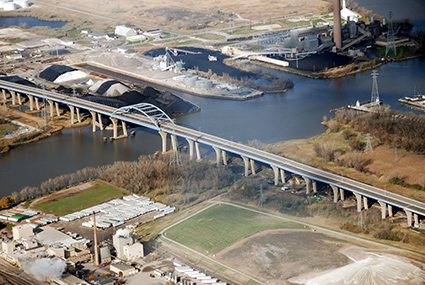 Overview
Overview
On February 17, 2017, the Federal Highway Administration (FHWA) set the
final rule for infrastructure performance measures. This rule required State DOT’s to establish performance measures consisting of four pavement measures and two bridge measures.
Poor pavement condition can result in increased wear on vehicles, increased fuel consumption costs and rough rides for travelers. Pavement measures report the conditions of highways in the National Highway System (NHS) as either good or poor based on the International Roughness Index (IRI). It also includes ratings for faulting, cracking and rutting.
Because bridges are critical links in the transportation system, Wisconsin gives the highest highway funding priority to bridge projects. Bridge measures report on the conditions of the deck area, superstructure, substructure and culvert. They are classified as good or poor based on National Bridge Inventory (NBI)
ratings. Wisconsin has 14,198 total bridges; 8,889 are locally owned and 5,309 are state owned as defined by FHWA as having a span length greater than 20 feet.
Goal
Improve the National Highway System (NHS) infrastructure of interstate pavement and both interstate and non-interstate bridge condition.
Targets
Targets were established based upon review of historical data and projecting the trend forward using this data.
How are targets set?
Good is defined as ‘no major investment is needed’ and poor is ‘reconstruction investment is needed’. Two-year and four-year targets for each measure were established on May 20, 2018. WisDOT and other state DOT’s can adjust their targets during the mid-performance period, which occurs on October 1, 2020.
Reporting Frequency
Data is reported to FHWA annually in October.
Wisconsin drives and inspects pavement annually and performs bi-yearly safety inspections and condition assessments of bridges. This is the designated frequency in National Bridge Inspection Standards (NBIS). Through these inspections, condition rating data is collected for the deck, superstructure and substructure with an overall rating of
good, fair or poor condition.
Progress
The first reporting for these metrics was sent to FHWA on October 1, 2018. View prior year’s results on FHWA’s Transportation Performance Management (TPM) State Highway Infrastructure
dashboard.
Measures:
- Interstate Pavement in good condition
- Interstate Pavement in poor condition
- Non-Interstate National Highway System (NHS) Pavement in good condition
- Non-Interstate National Highway System (NHS) Pavement in poor condition
- National Highway System (NHS) bridges in good condition
- National Highway System (NHS) bridges in poor condition
In Wisconsin
As part of our MAPSS (Mobility Accountability Preservation Safety Service) Performance Improvement Program, Wisconsin measures and reports the percent of our backbone and non-backbone highway pavement rated fair or above using the Pavement Condition Index (PCI).
The FHWA pavement rating metrics of “good," “fair," and “poor" allow national comparisons of NHS condition, using data all states can reasonably collect. Although WisDOT understands the utility a simplified measure provides for broad national comparisons, WisDOT prefers the use of the Pavement Condition Index (PCI) method to assess state highway conditions. PCI is an American Society of Testing and Materials standard (ASTM D6433-11) that has been widely accepted and used by transportation agencies since its development in the 1970s. PCI is a comprehensive pavement condition measure that involves the identification and measurement of unique distress types for developing accurate condition ratings. PCI provides key information about the causative factors creating the distresses defining pavement condition, information that is essential to the development of cost-effective improvement plans.
Wisconsin's MAPSS program also measures and reports on state bridge conditions. We have a rigorous bridge asset management process to maintain bridges in service, which includes: routine maintenance and repair, rehabilitation of key components, and bridge replacement. Wisconsin gives the highest priority to bridge projects in its overall asset management strategies. Local authorities are responsible for maintaining their bridges, and the department is responsible for ensuring they follow the proper procedures for operating and determining the safe carrying capacity of these bridges.
For more information regarding how we are doing in these areas, please explore the most current
MAPSS Preservation Scorecard.